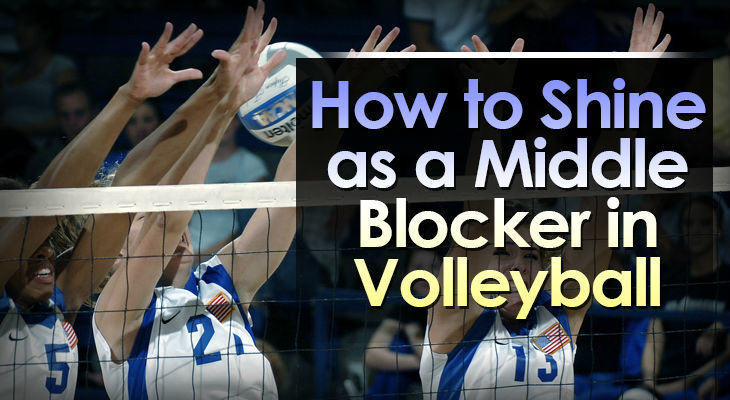How to Shine as a Middle Blocker in Volleyball
Volleyball is one of the best examples of what a team sport should be like, as all players determine the success or failure of every single play.
And the middle blocker is a key part of this puzzle.
Being essential to both the offence and defence.
As the name indicates, the middle blocker is primarily a defensive player.
Their primary role defensively is to find the attack and partner in a block attempt.
However, middle blockers are also frequently used as hitters during attacks.
And that’s not all…
They’re required to read the game, and provide inputs that help determine the opposition’s moves during each play.
So clearly, the middle blocker is more than just a shield for the opponents to break through.
And if you want to really excel in the position, you should know the key traits of a good middle blocker…
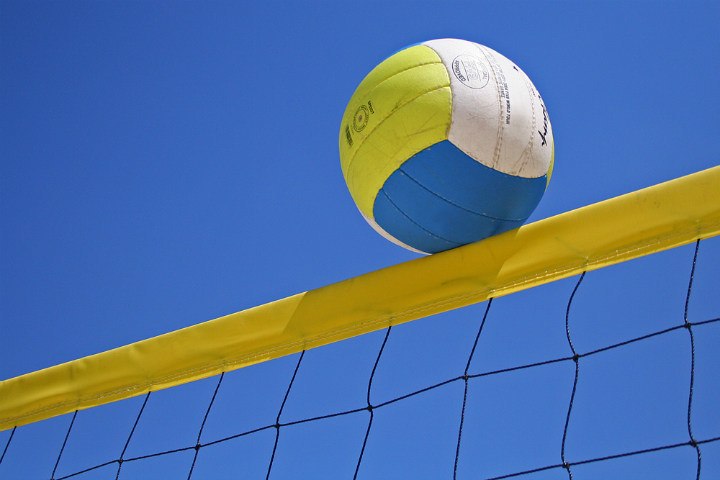
The Five Traits of a Great Middle Blocker
A quality middle blocker has a number of characteristics that set them apart from other positions on the team.
These traits are a mix of both natural-born abilities, as well as those learned through training and experience.
Let’s look at the key ones you need to become a great middle blocker….
1. Height
There’s no getting past this…
The typical middle is often the tallest player on the team.
After all, their main responsibility is blocking attacks by setting up high blocks using their heigh and long arms.
Their height is also a big factor in attack, since middle hitters must compete with the opposing blockers.
2. Athleticism
The typical middle normally conjures up the image of a lumbering, uncoordinated giant…
But you’d be surprised how light they can be on their feet and quick in their movements.
They have to be to be able to do their job well.
The middle must be quick both in their jumping and lateral movements to be able to react in time to stop the opposition attack.
Exceptional jumping power and speed of movement are also great advantages in attack to get over or ahead of an opponent’s block.
3. Volleyball Intelligence
After the setter, who’s like the team’s “quarterback”, the middle is often the most involved player tactically.
They must constantly anticipate the opposition’s moves to stay ahead and get to the block. This can be difficult as they often have to cover large distances to get into position.
With good anticipation and volleyball intelligence, even the tiniest of advantages gained can be the key to a successful move for them.
Similarly, they must make mental notes of pockets of space in the opposition’s formation to best place their spikes.
4. Observant
A great middle blocker is always aware of their surroundings.
Being aware of the positioning and movements of opponents helps a middle to make key decisions like the timing of their jumps and the angle of their blocks.
Likewise, awareness of the weaknesses of their own teammates helps them to understand which teammates need more cover.
Gaining an advantage starts well before the first serve.
As the opponent warms up, watching the traits, habits, and preferences of opponents can make a big difference.
For example, if a middle blocker understands that a particular hitter prefers an inside set, they can anticipate this and be lined up accordingly on defense.
5. Communicative
Again, aside from the setter, the middle blocker needs to be the most vocal amongst the players on the court.
It is vital that a middle blocker be in constant contact with those in the back-row. The teammates there have a different view of the unfolding game, and their inputs are valuable for the middle near the net.
The middle blocker is also responsible for communicating developments in a play based on the opponent’s pass.
If a pass is poor, or off the net, the middle should make others aware.
That way the setter and hitters can come up with a different, more advantageous attack.
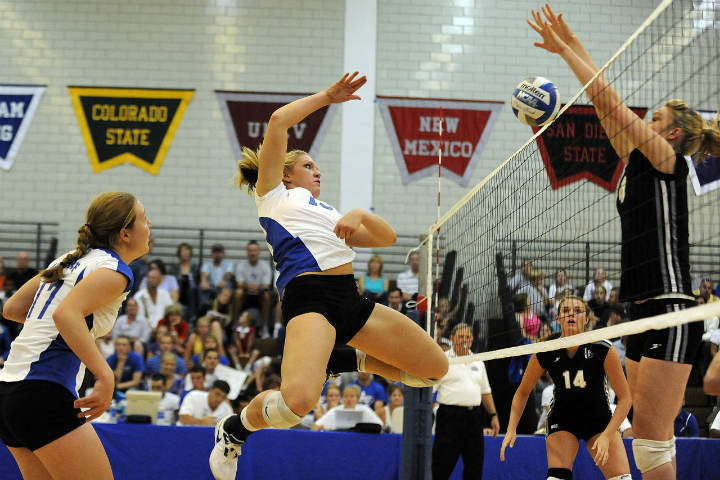
Responsibilities of a Middle Blocker
The setter may be quarterback on offence, but the middle blocker plays a similar role on defence.
And they’re involved in every single play, one way or the other.
So if you’re planning on taking up the role of the middle for your team, you should be aware of your various responsibilities during a game.
Let’s run through them one by one…
1. Playing the Main Blocker on Defence
Blocking on defense is the middle’s main responsibility.
This core role sets the tone defensively, and also influences the way the opposition attacks.
If you display solid technique and a great ability to organise others, it can intimidate and corner the opposition attack.
As the middle blocker on defence, your role is to be focused on:
• Reading the moves of the opponent’s attacks
• Moving quickly to track or close down their hitters
• Get in perfect position ahead of them
• Get in a solid block to either return or retain the ball
2. Playing a Hitter or a Decoy in Attack
On the attack, the middle blocker turns into the middle hitter, and will either:
• Be a hitter on an assigned play
• Be prepared for a quick set to the middle for an immediate attack
The middle hitter will often run very quick plays with sets barely above the net.
These quick attacks catch the opponent off guard, eliminating their ability to set up a double block or get in appropriate defensive position.
The middle hitter also plays the role of decoy on quite a few offensive plays.
While the setter is setting an outside or weak-side hitter, the middle might suddenly make an approach to draw the attention of the opposition.
This often opens attacking lanes for other hitters, as the opponent blocks are delayed or eliminated altogether by the fake.
3. Reading the Opposition and the Game
Middle blockers must always be alert to the movement of:
• The ball
• The opponent hitters, especially their ace or “go-to” hitter
• The opposite setter with regard to their rotation
Watching the passes and movements of opponent hitters allows the middle to anticipate the power and angles of attacks.
Likewise, knowing the current position of the opposite setter gives them significant clues about incoming attacks since most attacks hinge on the setter.
4. Communication
Communication is vital is volleyball to:
• Execute plays smoothly
• Avoid potential errors
• Exploit any opportunities that open up mid-play
And a good middle blocker plays an integral role in all of this.
The middle must call out teammates who are out of position, and quickly relay anything of use from their reading of the game.
Particularly, they must be constantly in touch with the back row, who have the best view of the game.
Timely calls can make or break moves. And a middle who is alert and vocal makes for a tough opponent.
5. Being a Leader on the Floor
Middle blockers must see themselves as the leaders of the team.
Every play in offence or defence involves the middle directly, or information the middle blocker has provided.
It’s important that you as the middle embrace your necessity and influence on the team, both during and in between plays.
You will often see great middle blockers be the first to celebrate with teammates, or pump them up between plays.
Little things like these help keep the atmosphere charged up and the team motivated in their quest for victory.
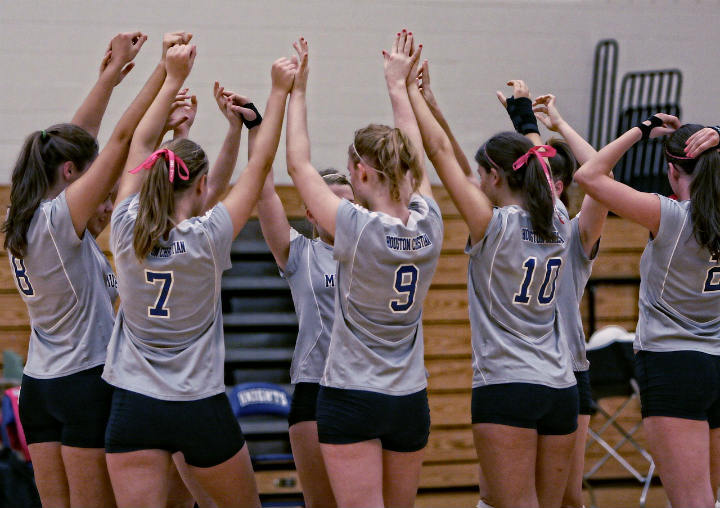
10 Essential Tips for Becoming a Great Middle Blocker
We mentioned earlier that a good middle blocker has both natural talent and the accumulated experience from playing and training.
It’s time to get to the second bit…
Here are the top tips for middle blockers to train with, and to gain an edge over opponents during games:
1. Getting Your Stance Right
This is the most basic thing you must get right to be a good middle blocker.
Beginners are often found standing too straight or upright before a play.
They probably think standing tall like that might intimidate opponents.
But regardless of whether that works or not, it certainly slows down the speed of their own reactions.
Maintaining a relatively loose stance, with knees slightly bent, and your weight balanced equally on both feet, keeps you better prepared.
Imagine a coiled spring. It’s the same concept.
And this stance is important for both jumping and moving quickly sideways.
2. Standing the Right Distance from the Net
Getting your initial position right is key to pulling off a great block.
Stand too close to the net, and you’re likely to commit a net violation.
Stand too far, and you can’t “penetrate” the net.
Penetrating the net, or getting your hands in front of the opponent’s hitting space is important. It narrows their field of vision and their tightens up their options with respect to the route or angles they wish to spike.
Blockers who don’t do this often find the ball rolling down their chest into their own half.
3. Work on Quickly Absorbing and Relaying Information
You already know this is key to your success as a middle blocker.
The middle spends most of their time looking across the net.
Learn to be mindful during these times to pick up on whatever information you can, and not just stand around.
With every glance around, look for new data that can improve your defensive organisation and attack moves.
Pass on whatever is useful to the setter and the teammates as soon as you can.
Do this consistently during trainings and drills to make it entirely a part of your game.
4. Carefully Observe the Initial Pass
The first pass of an opponent can tell the middle almost everything they need to know about the impending attack.
For instance:
• If the pass is off the net or off target, the setter is forced into a more predictable play.
• If the setter is pushed far off centre, their options become very limited.
• If the pass is tight to a front row setter, be ready for a dump or tip near the net
Reading the first pass is key to preparing for a solid block.
5. Use both hands
While blocking is obviously done with both hands, most blockers put them together to act as one solid block.
This is fine in an ideal block with a straight on attack.
And it’s ok for beginners looking to build a solid foundation with their technique.
However, using two hands individually provides a much more sophisticated defense.
As you grow more advanced with your technique, being able to use each hand independently will greatly improve your ability to block different angles.
You can also learn to cover the hitter’s preferred angles, or bait them into mistakes by changing your spread.
All this greatly increases your options in the air, solidifying your ability as a middle blocker.
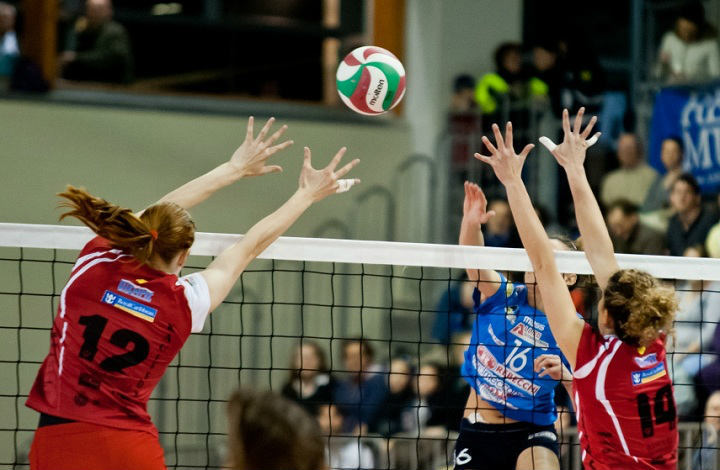
6. Work in Tandem with Your Setter
The middle blocker/hitter and the setter essentially run the game for the team together.
So unless they are constantly communicating with each other, there are bound to be a bunch of errors and missed opportunities for the team.
As the middle blocker, your inputs are important to the setter for transitioning quickly and smoothly from defence to offence.
Ideally, the duo should have set signals for deciding the tempo of moves, placement of passes, and timing of sets.
You could practice a bunch of things in training to develop this relationship, like:
• Having a number of verbal and non-verbal cues for certain moves
• Constant acknowledgement and confirmation of set plays through talking or nodding
• Constant feedback about plays executed
Also, make sure to practice a wide variety of spiking options with your setter(s) to make the most of your time as a middle hitter.
You could practice:
• Different angles of approach, as well as spiking
• Different tempos of attack
• Decoy or fake-out moves involving other hitters
7. Improve Your Attacks
Most middle blockers aren’t viewed as major threats in attack by opponents.
There’s usually an ace spiker or a go-to wing spiker that many setters base their patterns on.
But if you seriously train to strengthen and vary your attacks as a middle hitter, you can really up your team’s haul of points.
Here are some things to try with your hitting:
• Consistently maintaining the same approach to keep opponent blockers guessing
• Practicing a variety of hits and tips and with different angles
Practice fake-out spikes that convert to tips, vertically downward spikes, or simple fakes to open it up for other hitters.
8. Explosiveness is More Important than Height
A common mistake beginners make is to always try and out-jump the opposition.
For a blocker, it’s more about jumping speed rather than jumping power.
More often than not, hitters usually spike the ball just above the net.
So as the blocker, it’s enough that you get over the net rather than reach as high as you can past it.
For that, more than a high jump that requires a long wind-up, you should train to jump quickly and explosively to clear the net as soon as you can.
Additionally, you must learn to make crucial decisions regarding your blocking angles, etc. before or as you jump.
Out-jumping the hitter, but arriving too late, or being hesitant while you’re blocking, is sometimes as good as not trying at all.
9. Don’t Slap at the Ball
Your goal as blocker isn’t to smack the ball back into the opponent’s half.
It’s enough to either:
• Have the opponent’s spike drop back meekly into their half
• Shave off enough momentum by deflecting it for it to be a comfortable play for your team
You want to be a wall, not a counter-spiker.
For a good block, practice doing the following:
• Keep your hands firm, but not overly rigid
• Don’t slap at the ball
10. Mind the Gaps Between Fellow Blockers
Many beginners who play blockers make the mistake of leaving gaps in their “wall” while blocking with others.
An accomplished hitter can easily thread the needle between two poorly positioned blockers, as if the wall never existed.
So practice to weed out these mistakes during drills and trainings.
Pin yourself to the next blocker, and don’t leave enough space for the ball to squeeze through between your hands.
Conclusion
The ideal middle blocker is always in the thick of things, much like the setter.
They’re always wired into the ongoing play, carefully reading the opponent, calculating moves, and organising teammates accordingly.
They’re like a second leader on the floor, the brains of the defence, and working alongside the setter seamlessly into offence.
It’s an incredibly fun position to play.
And one that needs more than a good height and jumping ability to excel in.

